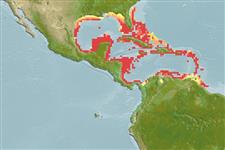Environment: milieu / climate zone / depth range / distribution range
Sinh thái học
Biển Cùng sống ở rạn san hô; không di cư; Mức độ sâu 1 - 70 m (Ref. 9710). Subtropical; 33°N - 35°S, 99°W - 28°W (Ref. 55265)
Western Atlantic: Florida, USA and Gulf of Mexico to Brazil. Eastern Central Atlantic: St. Paul's Rocks (Ref. 13121).
Length at first maturity / Bộ gần gũi / Khối lượng (Trọng lượng) / Age
Maturity: Lm 22.0 range ? - ? cm
Max length : 45.0 cm TL con đực/không giới tính; (Ref. 4858); common length : 30.0 cm TL con đực/không giới tính; (Ref. 3797); Khối lượng cực đại được công bố: 1.6 kg (Ref. 26340)
Các tia vây lưng cứng (tổng cộng) : 14; Các vây lưng mềm (tổng cộng) : 19 - 21; Tia cứng vây hậu môn: 3; Tia mềm vây hậu môn: 20 - 21. Tail and pectoral fins entirely yellow. Black spot on forehead has electric blue spots and is surrounded by narrow, electric blue ring. Large blue spot at base of pectoral fin (Ref. 26938). Adults develop short spines on the margin. The color of large adults is purplish blue with yellow-orange rims to the scales; head above eye dark blue, below greenish yellow; mouth, chin, throat, chest and abdomen purplish blue (Ref. 13442)
Found on coral reefs. Generally occurs solitarily or in pairs. Moves gracefully between seafans, seawhips, and corals (Ref. 9710). Stomach contents of 26 specimens indicate that the species feeds almost exclusively on sponges supplemented by small amounts of algae, tunicates, hydroids and bryozoans. Young pick ectoparasites from other fishes (Ref. 9710). Marketed fresh (Ref. 3797).
Life cycle and mating behavior
Maturities | Sự tái sinh sản | Spawnings | Egg(s) | Fecundities | Ấu trùng
Allen, G.R., 1985. Butterfly and angelfishes of the world. Vol. 2. 3rd edit. in English. Mergus Publishers, Melle, Germany. (Ref. 4858)
IUCN Red List Status (Ref. 130435)
Threat to humans
Reports of ciguatera poisoning (Ref. 30303)
Human uses
Các nghề cá: buôn bán nhỏ; Bể nuôi cá: Tính thương mại
Các công cụ
Special reports
Download XML
Các nguồn internet
Estimates based on models
Preferred temperature (Ref.
123201): 24.2 - 28, mean 26.7 °C (based on 220 cells).
Phylogenetic diversity index (Ref.
82804): PD
50 = 0.5078 [Uniqueness, from 0.5 = low to 2.0 = high].
Bayesian length-weight: a=0.03162 (0.01629 - 0.06139), b=2.89 (2.72 - 3.06), in cm total length, based on LWR estimates for this species & (Sub)family-body (Ref.
93245).
Mức dinh dưỡng (Ref.
69278): 3.0 ±0.0 se; based on diet studies.
Thích nghi nhanh (Ref.
120179): thấp, thời gian nhân đôi của chủng quần tối thiểu là 4.5 - 14 năm (Preliminary K or Fecundity.).
Fishing Vulnerability (Ref.
59153): Low to moderate vulnerability (35 of 100).
Nutrients (Ref.
124155): Calcium = 23.7 [10.8, 43.4] mg/100g; Iron = 0.489 [0.281, 0.849] mg/100g; Protein = 19 [18, 20] %; Omega3 = 0.146 [0.085, 0.251] g/100g; Selenium = 17.6 [8.3, 37.8] μg/100g; VitaminA = 35.8 [8.6, 142.1] μg/100g; Zinc = 0.792 [0.515, 1.183] mg/100g (wet weight);
